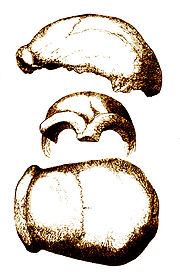
Neanderthal 1
Encyclopedia

Neanderthal
The Neanderthal is an extinct member of the Homo genus known from Pleistocene specimens found in Europe and parts of western and central Asia...
specimen found in Kleine Feldhofer Grotte
Kleine Feldhofer Grotte
Kleine Feldhofer Grotte was a cave, a paleoanthropologic site in the Neandertal Valley in northern Germany. In 1856, 60 Neanderthal specimens were unearthed from the cave...
in August 1856. It represents the beginning of paleoanthropology
Paleoanthropology
Paleoanthropology, which combines the disciplines of paleontology and physical anthropology, is the study of ancient humans as found in fossil hominid evidence such as petrifacted bones and footprints.-19th century:...
as a scientific
Science
Science is a systematic enterprise that builds and organizes knowledge in the form of testable explanations and predictions about the universe...
discipline.
The discovery was made in Feldhofer grotto
Kleine Feldhofer Grotte
Kleine Feldhofer Grotte was a cave, a paleoanthropologic site in the Neandertal Valley in northern Germany. In 1856, 60 Neanderthal specimens were unearthed from the cave...
in a limestone
Limestone
Limestone is a sedimentary rock composed largely of the minerals calcite and aragonite, which are different crystal forms of calcium carbonate . Many limestones are composed from skeletal fragments of marine organisms such as coral or foraminifera....
quarry
Quarry
A quarry is a type of open-pit mine from which rock or minerals are extracted. Quarries are generally used for extracting building materials, such as dimension stone, construction aggregate, riprap, sand, and gravel. They are often collocated with concrete and asphalt plants due to the requirement...
located in Neanderthal, Germany
Neanderthal, Germany
The Neandertal is a small valley of the river Düssel in the German Federal State of North Rhine-Westphalia, located about east of Düsseldorf, the capital city of North Rhine-Westphalia. The valley belongs to the area of the towns Erkrath and Mettmann...
. Neanderthal 1 consisted of a skull cap
Calvaria (skull)
The calvaria is the upper part of the cranium and surrounds the cranial cavity containing the brain.The calvaria is made up of the frontal, occipital and right and left parietals....
, two femora, the three right arm
Arm
In human anatomy, the arm is the part of the upper limb between the shoulder and the elbow joints. In other animals, the term arm can also be used for analogous structures, such as one of the paired forelimbs of a four-legged animal or the arms of cephalopods...
bone
Bone
Bones are rigid organs that constitute part of the endoskeleton of vertebrates. They support, and protect the various organs of the body, produce red and white blood cells and store minerals. Bone tissue is a type of dense connective tissue...
s, two of the left arm bones, ilium
Ilium (bone)
The ilium is the uppermost and largest bone of the pelvis, and appears in most vertebrates including mammals and birds, but not bony fish. All reptiles have an ilium except snakes, although some snake species have a tiny bone which is considered to be an ilium.The name comes from the Latin ,...
, and fragments of a scapula
Scapula
In anatomy, the scapula , omo, or shoulder blade, is the bone that connects the humerus with the clavicle ....
and ribs. The fossils were given by quarry workers to a local teacher
Teacher
A teacher or schoolteacher is a person who provides education for pupils and students . The role of teacher is often formal and ongoing, carried out at a school or other place of formal education. In many countries, a person who wishes to become a teacher must first obtain specified professional...
and amateur naturalist
Natural history
Natural history is the scientific research of plants or animals, leaning more towards observational rather than experimental methods of study, and encompasses more research published in magazines than in academic journals. Grouped among the natural sciences, natural history is the systematic study...
, Johann Karl Fuhlrott. The description of the remains was determined by anatomist Hermann Schaffhausen. The find was announced jointly in 1857.
As well as the unique historical importance of this specimen it has continued to play a key role since its discovery.
In 1999 scientists announced that careful detective work had led them to some of the sediments from the now destroyed Feldhofer grotto
Kleine Feldhofer Grotte
Kleine Feldhofer Grotte was a cave, a paleoanthropologic site in the Neandertal Valley in northern Germany. In 1856, 60 Neanderthal specimens were unearthed from the cave...
with fragments of Neanderthal bones including one that fit exactly to the original femur.
In 1997 the Neanderthal type specimen was the first to yield ancient mtDNA sequences.

See also
- List of fossil sites (with link directory)
- List of hominina (hominid) fossils (with images)

